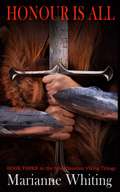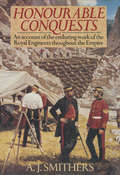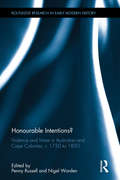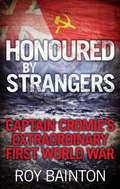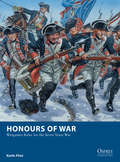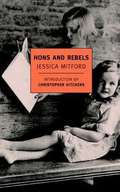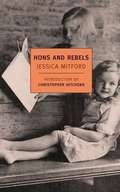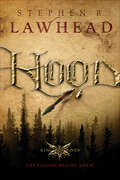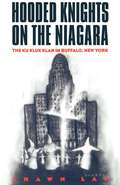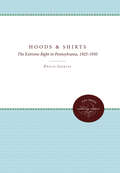- Table View
- List View
Honour is All: The Shieldmaiden Trilogy
by Marianne WhitingYou are your father's daughter A young Viking woman picks up her sword and goes in search for retribution and justice. In 934 the English are fighting the Norse for supremacy over the North. Worship of the old Norse gods is challenged by Christianity. Traditional loyalties are tested and revenge can be swift and violent. In Cumbria a man is outlawed and killed. Faced with a life of destitution and servitude, his daughter Sigrid's only option is to appeal to the King of Norway to reverse his judgement on her father and allow her to inherit the family farm. But Norway is far away and Sigrid has only her wits and her skill with the sword to help her cause. Sigrid sets out to regain her birthright, encountering kings, warriors and villains on her quest. While her fighting skills earn her admiration, she must also learn about duty, honour and loyalty if she is to grow from a headstrong teenager into a woman and a respected warrior.
Honour: Achieving Justice for Banaz Mahmod
by Caroline GoodeWhen Rahmat Sulemani reported his girlfriend Banaz missing, it quickly became clear to DCI Caroline Goode that something was very wrong. In fact, Banaz had contacted her local police station multiple times before, even listing the names of the men she expected to murder her in a so-called 'honour' killing. Her parents didn't seem worried, but Banaz had already accused them of being part of the plot.DCI Goode's team took on the investigation before they even had proof that a murder had taken place. What emerged was a shocking story of betrayal and a community-wide web of lies, which would take the team from suburban south London to the mountain ranges of Kurdistan, making covert recordings and piecing together cell phone data to finally bring the killers to justice.
Honourable Conquests: An Account of the Enduring Work of the Royal Engineers Throughout the Empire
by A. J. SmithersThe origin of the Corps of Royal Engineers, now affectionately known as The Sappers but then as the King's Military Engineers, has been traced as far as 1414, though it was not until 1716 that a permanent officer corps of engineers was established by the Board of Ordnance with the title Corps of Engineers.. Being part of the Regular Army it is hardly surprising that the Corps should be associated in the public mind with such tasks as building roads, bridges and defensive works or breaching those of the enemy and scant attention was hitherto been paid to the remarkable achievements of the Corps in times of peace. In Honourable Conquests A.J. Smithers sets out to redress that balance. Britain having acquired an Empire, more by accident than design, it fell to the lot of the Army, first in India and later in other parts of the Empire, to act in the role of unofficial Colonial Policemen As well we all know, the policemens lot is not a happy one, so the ingenious Engineers found better ways to pass the time,thereby leaving behind them some remarkable testimonies, not only to their professional skills but to their very considerable contribution to the welfare of mankind- in India, in Canada, in Australia and other parts of the Empire. It is to such men as General Pasley Colonel By, General Cotton and Sir Colin Scott Moncrieff, truly great men now all but forgotten, on whom Smithers turns his narrative skill and wry humour in this fascinating book. As the completion of the Channel Tunnel approaches, his penultimate chapter concerning the involvement of the Royal Engineers with that project over a hundred years ago will be of particularly topical interest.
Honourable Intentions (The Honour Series #4)
by Gavin LyallThis historical thriller set in 1914 brings the acclaimed British author’s “splendidly entertaining” Honour series to an explosive conclusion (The Guardian). As Europe hurdles toward World War I, the French American anarchist Grover Langhorn is arrested in London. But before he can be extradited to face trial, he reveals a secret more threatening to the crown than any bomb: Langhorn is King Henry V’s illegitimate son—and heir to the throne. Now Cpt. Matthew Ranklin and his partner Conall O’Gilroy of the newly formed British Secret Service are tasked with investigating Langhorn’s audacious—yet credible—claim. But in order to save the king from himself, they must delve into the unseemly secrets of his past. And soon they discover that closing this case will require opening a Pandora’s box of mayhem, murder, and international conspiracy.
Honourable Intentions?: Violence and Virtue in Australian and Cape Colonies, c 1750 to 1850.
by Nigel Worden Penny RussellHonourable Intentions? compares the significance and strategic use of ‘honour’ in two colonial societies, the Cape Colony and the early British settlements in Australia, between 1750 and 1850. The mobile populations of emigrants and sojourners, sailors and soldiers, merchants and traders, slaves and convicts who surged into and through these regions are not usually associated with ideas of honour. But in both societies, competing and contradictory notions of honour proved integral to the ways in which colonisers and colonised, free and unfree, defended their status and insisted on their right to be treated with respect. During these times of flux, concepts of honour and status were radically reconstructed. Each of the thirteen chapters considers honour in a particular sphere - legal, political, religious or personal - and in different contexts determined by the distinctive and changing matrix of race, gender and class, as well as the distinctions of free and unfree status in each colony. Early chapters in the volume show how and why the political, ideological and moral stakes of the concept of honour were particularly important in colonial societies; later chapters look more closely at the social behaviour and the purchase of honour among specific groups. Collectively, the chapters show that there was no clear distinction between political and social life, and that honour crossed between the public and private spheres. This exciting new collection brings together new and established historians of Australia and South Africa to highlight thought-provoking parallels and contrasts between the Cape and Australian colonies that will be of interest to all scholars of colonial societies and the concept of honour.
Honourable Misfits: A Brief History of Britain's Weirdest, Unluckiest and Most Outrageous MPs
by Marie Le ConteHonourable Misfits is a weird and wonderful celebration of the most eccentric and infamous MPs throughout the history of the British parliament.Politicians are weird - we can all agree on that. But do you know how much weirder they used to be? If not, Honourable Misfits is the audiobook for you. Spanning from the past 700 years, this is a celebration of the oddest and most eccentric MPs the House of Commons has ever seen. From mad inventors and fearless adventurers to machiavellian villains and mavericks with more money than sense, it offers 64 pen portraits of the unique, the mysterious and the downright deranged.There is the one who built a complex network of tunnels and underground rooms underneath his estate; the one who liked to go hunting naked; the one who set himself on fire to cure his hiccups, and the one who invented a very small gun with which to kill flies.Still, they weren't all useless; there was also the MP who invented weather forecasts, and the one who documented more animal species than nearly everyone else. They weren't all good either; between the fascist turned Buddhist monk and the spy who faked his death, there are more than enough villains to go around. They also weren't all lucky; included in Honourable Misfits are tributes to MPs with tragic deaths, from falling on a turnip to getting in a car accident the day after getting elected. This is an audiobook to celebrate human nature in all its odd, compelling complexity.(P)2021 Hodder & Stoughton Limited
Honourable Misfits: A Brief History of Britain's Weirdest, Unluckiest and Most Outrageous MPs
by Marie Le ContePoliticians are weird - we can all agree on that. But do you know how much weirder they used to be? If not, Honourable Misfits is the book for you. Spanning from the past 700 years, this is a celebration of the oddest and most eccentric MPs the House of Commons has ever seen. From mad inventors and fearless adventurers to machiavellian villains and mavericks with more money than sense, it offers 64 pen portraits of the unique, the mysterious and the downright deranged.There is the one who built a complex network of tunnels and underground rooms underneath his estate; the one who liked to go hunting naked; the one who set himself on fire to cure his hiccups, and the one who invented a very small gun with which to kill flies.Still, they weren't all useless; there was also the MP who invented weather forecasts, and the one who documented more animal species than nearly everyone else. They weren't all good either; between the fascist turned Buddhist monk and the spy who faked his death, there are more than enough villains to go around. They also weren't all lucky; included in Honourable Misfits are tributes to MPs with tragic deaths, from falling on a turnip to getting in a car accident the day after getting elected. This is a book to celebrate human nature in all its odd, compelling complexity.
Honourable Warriors: Fighting the Taliban in Afghanistan
by Richard StreatfeildIn 2009 Major Richard Streatfeild and his men fought for six months against the Taliban in Sangin, northern Helmand. They were engaged in over 800 fire-fights. They were the target of more than 200 improvised explosive devices. Ten men in his company were killed, 50 were wounded. This is their story and it is the story, from the front line, of Western intervention in Afghanistan. His graphic personal account gives an inside view of the physical, psychological and political battle to come to terms with severe casualties and the stress of battle while seeking the support of the local population. It is also an account of strategy being turned into action - of the essential interplay of the personal and professional in the most testing of circumstances. He describes the day-to-day operations, and he provides a fascinating record of the Taliban's guerrilla tactics and the British response to them. His narrative gives a direct insight into the experiences of soldiers who had to face down their fear throughout a prolonged tour of duty on the Afghan battlefield.His narrative is essential reading for anyone who cares to understand the nature of the war in Afghanistan and how the odds are stacked against the army's success. For the British intervention in Helmand is a microcosm of the Nato-led mission launched against the Taliban and al Qaeda.As seen in The Daily Mail, The Guardian, The Mail on Sunday, Sussex Express and The Argus, Featured on BBC Radio 4 ' The Today' programme and on BBC South East Television
Honoured By Strangers: Captain Cromie's Extraordinary First World War
by Roy BaintonFor many years the story of Cromie has been overshadowed by histories of the greater tragedy found on the Western Front in World War I. Yet, like T E Lawrence, Cromie's individual exploits reveal a classic British hero: noble, tenacious and beloved by all who served under him. Churchill called him a man of exceptional gifts. Cromie became a submarine commander at the remarkably young age of 24. By this time he had already seen action in the Boxer Rebellion, received the China Medal and had been mentioned in despatches. His compassion and care for his men gained him the Royal Humane Society's Bronze Medal, when he almost lost his life attempting to save a drowning sailor. In 1915 he was chosen to head a flotilla of submarines to attack German shipping in the Baltic Sea. Here, he achieved great success despite the hazardous nature of the climate and the threat of the German navy. He was decorated three times by the Czarof Russia and received the DSO. During his three years in the Baltic he became fluent in Russian. He only survived the difficulties of the Bolshevik Revolution in 1917 because of his consummate skills as a mediator and diplomat. His murder in the British Embassy in 1918 at the age of 37 remained a tragic mystery for many years - until now. Bainton's extensive research has revealed why Cromie has previously been omitted from official histories of that difficult period. The circumstances surrounding his murder exposed facts about his complex character, his relationship with the Bolsheviks and the British Establishment - and importantly the story uncovers the duplicity of the allies as they struggled to formulate a reaction to the tidal wave of the Russian Revolution.
Honours Even
by Nigel TranterIn 1649 Charles II left his exile in the Netherlands and sailed toScotland. Arriving at the small fishing village of Garmouth, he faced amixed reception from the minister of the Kirk.The exiled king was to remain in Scotland for a year, learning moreabout his northern subjects, while the English tried to adjust to lifeunder the puritanical heel of the Lord Protector, Oliver Cromwell.But Cromwell was soon to turn his attentions to matters north of theborder. He coveted the Honours of Scotland - the crown, sceptres andsword-of-state - symbols of hope and the nations's honour.And so the young men of Scotland were forced into battle to save theHonours...The gripping story of Charles II's year in Scotland and Scotland's bravestand against Oliver Cromwell, told by Nigel Tranter, master of Scottishhistorical fiction.
Honours Even
by Nigel TranterIn 1649 Charles II left his exile in the Netherlands and sailed toScotland. Arriving at the small fishing village of Garmouth, he faced amixed reception from the minister of the Kirk.The exiled king was to remain in Scotland for a year, learning moreabout his northern subjects, while the English tried to adjust to lifeunder the puritanical heel of the Lord Protector, Oliver Cromwell.But Cromwell was soon to turn his attentions to matters north of theborder. He coveted the Honours of Scotland - the crown, sceptres andsword-of-state - symbols of hope and the nations's honour.And so the young men of Scotland were forced into battle to save theHonours...The gripping story of Charles II's year in Scotland and Scotland's bravestand against Oliver Cromwell, told by Nigel Tranter, master of Scottishhistorical fiction.
Honours of War
by Steve Noon Keith FlintThe Seven Years' War was the pinnacle of 18th-century warfare, with dramatic campaigns and battles, famous leaders, and wide variety of colourful uniforms. Compared with the later Napoleonic Wars, tactics were simpler, armies more professional, and battles tended to be smaller. Using these quick-to-learn rules, players can bring this period to the tabletop, recreating anything from a small skirmish to a major pitched battle. Although simple, the rules allow for a wide range of tactics and reward historical play. That said, fog of war sometimes produces unexpected results and units don't always obey their orders! The game movies quickly, and players must be prepared to regroup and counterattack or to press home an advantage - a lot can happen in one move!
Hons and Rebels
by Jessica MitfordIn this reprint of the 1960 and 1989 editions, Christopher Hitchens, a Vanity Fair columnist and visiting professor of liberal studies at the New School, introduces a memoir of the unconventional British upbringing of Jessica Mitford (1917-1997). The muckraking journalist is best known for The American Way of Death (1963), her exposé of the funeral industry. Mitford family photos are included. Annotation ©2004 Book News, Inc., Portland, OR (booknews.com)
Hons and Rebels: The Classic Memoir Of One Of Last Century's Most Extraordinary Families (New York Review Books Classics)
by Jessica Mitford Christopher HitchensJessica Mitford, the great muckraking journalist, was part of a legendary English aristocratic family. Her sisters included Nancy, doyenne of the 1920s London smart set and a noted novelist and biographer; Diana, wife to the English fascist chief Sir Oswald Mosley; Unity, who fell head over in heels in love with Hitler; and Deborah, later the Duchess of Devonshire. Jessica swung left and moved to America, where she took part in the civil rights movement and wrote her classic expos#65533; of the undertaking business, The American Way of Death. Hons and Rebels is the hugely entertaining tale of Mitford's upbringing, which was, as she dryly remarks, “not exactly conventional. . . Debo spent silent hours in the chicken house learning to do an exact imitation of the look of pained concentration that comes over a hen's face when it is laying an egg. . . . Unity and I made up a complete language called Boudledidge, unintelligible to any but ourselves, in which we translated various dirty songs (for safe singing in front of the grown-ups). ” But Mitford found her family's world as smothering as it was singular and, determined to escape it, she eloped with Esmond Romilly, Churchill's nephew, to go fight in the Spanish Civil War. The ensuing scandal, in which a British destroyer was dispatched to recover the two truants, inspires some of Mitford's funniest, and most pointed, pages. A family portrait, a tale of youthful folly and high-spirited adventure, a study in social history, a love story, Hons and Rebels is a delightful contribution to the autobiographer's art.
Honus Wagner: A Biography
by Dennis DeValeria Jeanne Burke DeValeriaAn in-depth biography of one of baseball's greatest legends, the speedy shortstop and power hitter, Honus Wagner, also known as the "the Flying Dutchman"."We think we have made a deal which will materially help us out," Fred Clarke, manager of the National Louisville Colonels, prophetically told the local media in 1897. "After negotiating for some days we have succeeded in securing Hans Wagner...He is a big, heavy German, with very large hands, and is powerful as a bull. He kills the ball." A few years later, the widely read sportswriter Hugh Fullteron would refer to Wagner as "the nearest approach to a baseball machine ever constructed."Honus Wagner is generally acknowledged as the finest shortstop in baseball history. Along with Babe Ruth, Ty Cobb, Christy Mathewson, and Walter Johnson, he was one of the first five players to be elected to the Baseball Hall of Fame. His rare 1909 baseball card--known to collectors as the Holy Grail of American memorabilia--fetched nearly half a million dollars at auction in 1991. His rise paralleled the development of baseball as the national pastime, and his playing skills remain legendary. He was, possibly, the first superstar of American sports.And yet, amazingly, a full-length biography of Honus Wagner had never before appeared. Here, Dennis and Jeanne DeValeria tell the sports hero's whole story. The son of German immigrants, Wagner (1874-1955) grew up in Andrew Carnegie's Pittsburgh, working in coal mines at age twelve. At age thirteen he worked in a steel mill; at twenty-one he was a professional baseball player. Despite his hardscrabble background, he came to be respected by those in the highest reaches of American society: when he became an icon, he would know President Howard Taft and industrialist Henry Ford. And with prestige came wealth: one of the highest-paid players in the game, he was among the first in his hometown to own an automobile. At a time when baseball was a raw, aggressive game played by rugged men, the unflappable Wagner's humble ways enhanced his miraculous performance throughout his twenty-one-year career, including three seasons with the Louisville Colonels and eighteen with the Pittsburgh Pirates. Wagner's gradual emergence from the pack into stardom and popularity is described here in rich detail. But the book also reveals much of Wagner's family and personal life--his minor league career, his values, his failed business ventures during the Depression, his later years--about which, until now, there had been no well known narrative.Neither the "rowdy-ball" ruffian nor the teetotal saint constructed of legend, Wagner is presented here in a complete portrait--one that offers a vivid impression of the era when baseball was America's game and the nation was evolving into the world's industrial leader.
Hoo-Doo Cowboys and Bronze Buckaroos: Conceptions of the African American West (Margaret Walker Alexander Series in African American Studies)
by Michael K. JohnsonHoo-Doo Cowboys and Bronze Buckaroos undertakes an interdisciplinary exploration of the African American West through close readings of texts from a variety of media. This approach allows for both an in-depth analysis of individual texts and a discussion of material often left out or underrepresented in studies focused only on traditional literary material. The book engages heretofore unexamined writing by Rose Gordon, who wrote for local Montana newspapers rather than for a national audience; memoirs and letters of musicians, performers, and singers (such as W. C. Handy and Taylor Gordon), who lived in or wrote about touring the American West; the novels and films of Oscar Micheaux; black-cast westerns starring Herb Jeffries; largely unappreciated and unexamined episodes from the "golden age of western television" that feature African American actors; film and television westerns that use science fiction settings to imagine a "postracial" or "postsoul" frontier; Percival Everett's fiction addressing contemporary black western experience; and movies as recent as Quentin Tarantino's Django Unchained.Despite recent interest in the history of the African American West, we know very little about how the African American past in the West has been depicted in a full range of imaginative forms. Hoo-Doo Cowboys and Bronze Buckaroos advances our discovery of how the African American West has been experienced, imagined, portrayed, and performed.
Hood Canal
by Mike FredsonFjord-like Hood Canal channels beneath the snowcapped Olympic National Park, creating a summer paradise of warm days and inspiring scenery as well as a haven for marine life and watercraft. For eons, Twana Indians crisscrossed in canoes that sliced through water like salmon. The canal's first tourist, Captain Vancouver, sailed a launch down the scenic route in 1792. For the next century, a mosquito fleet of tugboats, stern-wheelers, fishing boats, and barges ferried the men who came for logging or land. By 1889, lumberman and legislator John McReavy promoted Union City as "Venice ofthe Pacific." In the 20th century, canal use shifted from logging to recreation as wealthy Easterners, San Francisco expatriates, and artists founded hunting lodges, fishing resorts, and even an artist colony. The Navy Yard Highway introduced automobile tourism, and new resorts, including Alderbrook, soon dotted the shoreline. After World War II, families bought summer homes and ski boats. Now, in the 21stcentury, kayaks and personal watercraft skim across the waters, and the canal is more popular than ever.
Hood's Defeat Near Fox's Gap: Prelude to Emancipation
by Curtis L. OlderAn entirely new analysis of the battle for Fox’s Gap during the battle for South Mountain.Hood’s Defeat Near Fox’s Gap is an exceptional analysis of Confederate Brigadier General John Bell Hood’s troop movements during the battle of South Mountain. For the past 160 years, all other authors misplaced Hood’s troop positions on the Fox’s Gap battlefield by approximately a half-mile. The actual location of Hood's attack reconfigures the entire placement of the competing forces in the battle and, thus, the conclusions one makes about the struggle. Other authors did not correctly analyze the geography and topography of the battlefield. The failure to understand the topographical characteristics of the battlefield led other writers to make false assumptions about Hood's movement. Before the publication of Hood’s Defeat Near Fox’s Gap, the battle for Fox’s Gap and South Mountain was never accurately reported or understood.
Hood's Tennessee Campaign: The Desperate Venture of a Desperate Man (Civil War Series)
by James R. KnightThe Tennessee Campaign of November and December 1864 was the Southern Confederacy's last significant offensive operation of the Civil War. General John Bell Hood of the Confederate Army of Tennessee attempted to capture Nashville, the final realistic chance for a battlefield victory against the Northern juggernaut. Hood's former West Point instructor, Major General George Henry Thomas, led the Union force, fighting those who doubted him in his own army as well as Hood's Confederates. Through the bloody, horrific battles at Spring Hill, Franklin and Nashville and a freezing retreat to the Tennessee River, Hood ultimately failed. Civil War historian James R. Knight chronicles the Confederacy's last real hope at victory and its bitter disappointment.
Hood's Texas Brigade: The Soldiers and Families of the Confederacy's Most Celebrated Unit (Conflicting Worlds: New Dimensions of the American Civil War)
by Susannah J. UralOne of the most effective units to fight on either side of the Civil War, the Texas Brigade of the Army of Northern Virginia served under Robert E. Lee from the Seven Days Battles in 1862 to the surrender at Appomattox in 1865. In Hood’s Texas Brigade, Susannah J. Ural presents a nontraditional unit history that traces the experiences of these soldiers and their families to gauge the war’s effect on them and to understand their role in the white South’s struggle for independence.According to Ural, several factors contributed to the Texas Brigade’s extraordinary success: the unit’s strong self-identity as Confederates; the mutual respect among the junior officers and their men; a constant desire to maintain their reputation not just as Texans but as the top soldiers in Robert E. Lee’s army; and the fact that their families matched the men’s determination to fight and win. Using the letters, diaries, memoirs, newspaper accounts, official reports, and military records of nearly 600 brigade members, Ural argues that the average Texas Brigade volunteer possessed an unusually strong devotion to southern independence: whereas most Texans and Arkansans fought in the West or Trans- Mississippi West, members of the Texas Brigade volunteered for a unit that moved them over a thousand miles from home, believing that they would exert the greatest influence on the war’s outcome by fighting near the Confederate capital in Richmond. These volunteers also took pride in their place in, or connections to, the slave-holding class that they hoped would secure their financial futures. While Confederate ranks declined from desertion and fractured morale in the last years of the war, this belief in a better life—albeit one built through slave labor— kept the Texas Brigade more intact than other units.Hood’s Texas Brigade challenges key historical arguments about soldier motivation, volunteerism and desertion, home-front morale, and veterans’ postwar adjustment. It provides an intimate picture of one of the war’s most effective brigades and sheds new light on the rationales that kept Confederate soldiers fighting throughout the most deadly conflict in U.S. history.
Hood: Hood, Scarlet, And Tuck (The King Raven Trilogy #Bk. 1)
by Stephen R. LawheadPrepare yourself for an epic tale that dares to shatter everything you thought you knew about Robin Hood.For centuries, the legend of Robin Hood and his band of thieves has captivated the imagination. Now the familiar tale takes on new life, fresh meaning, and an unexpected setting.Hunted like an animal by Norman invaders, Bran ap Brychan, heir to the throne of Elfael, has abandoned his father's kingdom and fled to the greenwood. There, in a primeval forest of the Welsh borders, danger surrounds him--for this woodland is a living, breathing entity with mysterious powers and secrets, and Bran must find a way to make it his own if he is to survive.Steeped in Celtic mythology and the political intrigue of medieval Britain, Stephen R. Lawhead conjures up an ancient past and holds a mirror to contemporary realities.Full-length Historical FantasyIncludes Author&’s Note: &“Robin Hood in Wales?&”Part of the King Raven seriesBook One: HoodBook Two: ScarletBook Three: Tuck
Hooded Americanism: The History of the Ku Klux Klan
by David J. Chalmers"The only work that treats Ku Kluxism for the entire period of it's existence. . . . the authoritative work on the period. Hooded Americanism is exhaustive in its rich detail and its use of primary materials to paint the picture of a century of terror. It is comprehensive, since it treats the entire period, and enjoys the perspective that the long view provides. It is timely, since it emphasizes the undeniable persistence of terrorism in American life--John Hope Franklin
Hooded Knights on the Niagara: The Ku Klux Klan in Buffalo, New York
by Shawn LayThey came in the dead of night, marking the homes and businesses of their enemies with crude symbols and dire warnings. They plotted against those of other religious faiths and circulated secret lists of alleged traitors to the community and nation. They mailed anonymous threats to those who refused to be intimidated into silence, all the while claiming that they were the true champions of American justice and freedom. The above may seem an accurate description of the sinister activities that distinguished the Ku Klux Klan in the early twentieth century, but in Buffalo, New York, and, in fact, throughout much of the northeastern United States, such activities were as characteristic of the Klan's opponents as of the hooded order itself. While the revived Klan of the 1920s-- the largest and most influential manifestation of organized intolerance in American history--proceeded with relative impunity in many locales, it encountered a very different situation in Buffalo where powerful enemies opposed the organization at every turn. Shawn Lay here provides a riveting portrayal of how the Klan established itself in Buffalo. Most chillingly, he explains how otherwise ordinary, well-established citizens, caught up in a complex set of circumstances, were persuaded to join a notorious secret society that pandered to the darkest impulses in American society.
Hoodlum Movies: Seriality and the Outlaw Biker Film Cycle, 1966-1972
by Peter StanfieldFrom The Wild Angels in 1966 until its conclusion in 1972, the cycle of outlaw motorcycle films contained forty-odd formulaic examples. All but one were made by independent companies that specialized in producing exploitation movies for drive-ins, neighborhood theaters, and rundown inner city theaters. <P><P>Despised by critics, but welcomed by exhibitors denied first-run films, these cheaply and quickly produced movies were made to appeal to audiences of mobile youths. The films are repetitive, formulaic, and eminently forgettable, but there is a story to tell about all of the above, and it is one worth hearing. <P><P>Hoodlum Movies is not only about the films, its focus is on why and how these films were made, who they were made for, and how the cycle developed through the second half of the 1960s and came to a shuddering halt in 1972.
Hoods and Shirts: The Extreme Right in Pennsylvania, 1925-1950
by Philip JenkinsExtreme right-wing groups have always been a part of the American religious and political landscape. The era between the world wars, especially the 1930s, was a particularly volatile period, and by 1940, racist, nativist, and fascist groups had become so visible as to arouse public fears of insurrection and sabotage. In Hoods and Shirts, Philip Jenkins uses developments in Pennsylvania as a case study of the local activities and broader significance of organizations such as the Ku Klux Klan, the Italian Black Shirts, the Silver Legion, the German-American Bund, and Father Coughlin's Christian Front. Pennsylvania's cities were a stronghold of several of the most active extremist movements, and Jenkins argues that while the threats they posed were often exaggerated to benefit the solidarity of the political mainstream, a loose coalition of dozens of these groups nevertheless constituted a formidable political presence in the state. In chapters on each of the major organizations, Jenkins traces their common commitment to a fascist agenda as well as the ethnic and religious differences that divided them. His comprehensive analysis sheds new light on how these right-wing movements influenced the mainstream of American politics in the interwar years.Originally published in 1997.A UNC Press Enduring Edition -- UNC Press Enduring Editions use the latest in digital technology to make available again books from our distinguished backlist that were previously out of print. These editions are published unaltered from the original, and are presented in affordable paperback formats, bringing readers both historical and cultural value.
